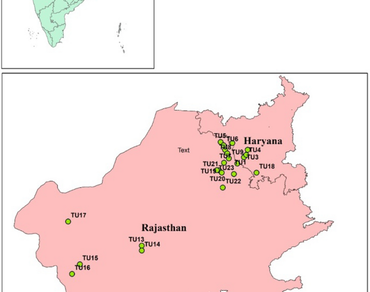Assessment of genetic diversity in Tecomella undulata by using ISSR markers
Daneva Vijay, Beniwal R. S., Kajla Subhash, Poonia Anil Kumar, Kumar Manish, Kajal
Research Articles | Published: 14 January, 2023
First Page: 1526
Last Page: 1534
Views: 3417
Keywords: DNA, Amplification, Base pairs, Polymorphism and genetic variation
Abstract
The present study was carried out to assess the genetic diversity among 24 genotypes of Tecomella undulata by using of inter simple sequence repeats (ISSR) markers. Leaves samples were used as the primary material for DNA extraction. The DNA from collected plants were screened for genetic diversity using 40 ISSR primers. The number of countable bands for each ISSR primer varied from 4 to 7. Thirteen ISSR primers produced 67 distinct bands, 42 bands were polymorphic while 25 were monomorphic. Overall size of PCR amplified products was ranged between 120 to 1450 bps. The percentage of polymorphism was also calculated for each primer and the maximum polymorphism was observed for primer ISSR 35 (85.71%) while minimum polymorphism was observed with primer ISSR 31 (40.00%). Average 62.36% polymorphism was detected amongst 24 genotypes of T. undulata using 13 ISSR primers. Genetic variation between all the genotypes using ISSR markers suggested that these markers are efficient tools for observing genetic relationship in particular tree species which can be utilized for breeding programs of T. undulata for developing new varieties.

References
Agarwal RK, Gupta JP, Saxena SK, Muthana KD (1976) Studies on soil physico-chemical and ecological changes under twelve years old five desert tree species of Western Rajasthan. Indian For 102:863–872
Anonymous (2003) UNEP Annual Evaluation. Report.http://wedocs.unep.org/handle/20.500.11822/87.
Anonymous (2005) WCMC World Database of Protected Areas. http:// www.unep-wcmc.org/wdpa.
Arya S, Toky OP, Harris SM, Harris PJC (1992) Tecomella undulata (Rohida): A valuable tree of the Desert. Int Tree Crops J 7(3):141–148
Bhau BS, Negi MS, Jindal SK, Singh M, Lakshmikumaran M (2007) Assessing genetic diversity of Tecomella undulata (Sm.)—an endangered tree species using amplified fragment length polymorphism based molecular markers. Curr Sci 93:67–72
Chakravarty AK, Chand G (1975) Phenotypic variation in desert teak . Ann Arid Zone 14:21–24
Chhajer S, Jukanti AK, Kalia RK (2017) Start codon targeted (SCoT) polymorphism based genetic relationships and diversity among populations of Tecomella undulata (Sm) Seem—an endangered timber tree of hot arid regions. Tree Genet Genomes 13:84
Chhajer S, Jukanti AK, Bhatt RK, Kalia RK (2018) Genetic diversity studies in endangered desert teak [Tecomella undulata (Sm.) Seem] using arbitrary (RAPD), semi-arbitrary (ISSR) and sequence based (nuclear rDNA) markers. Trees 32(4):1083–1101
Feyissa T, Nybom H, Bartish IV, Welander M (2007) Analysis of genetic diversity in the endangered tropical tree species Hagenia abyssinica using ISSR markers. Genet Resour Crop Evol 54:947–958
Johar V, Kajla S, Dhillon RS, Bhatia P (2017) Evaluation of genetic diversity using random amplified polymorphic DNA (RAPD) markers in Melia dubia Cav. Indian J Biotechnol 16:76–83
Kalia RK, Rai MK, Kalia S, Singh R, Dhawan AK (2011) Microsatellite markers: an overview of the recent progress in plants. Euphytica 177:309–334
Kalia RK, Rai MK, Sharma R, Bhatt RK (2014) Understanding Tecomella undulata: an endangered pharmaceutically important timber species of hot arid regions. Genet Resour Crop Evol 61:1397–1421
Khan TI, Frost S (2001) Floral biodiversity: a question of survival in the Indian Thar Desert. The Environment 21:231–236
Khurana VK, Kachhwaha S, Kothari SL (2012) Characterization of genetic diversity in Jatropha curcas L. germplasm using RAPD and ISSR markers. Indian J Biotechnol 11:54–61
Machua J, Muturi G, Omondi SF, Gicheru J (2011) Genetic diversity of Jatropha curcas L. populations in Kenya using RAPD molecular markers: Implication to plantation establishment. Afr J Biotechnol 10(16):3062–3069
Mahelkaa V, Krak K, Kopecký D, Fehrer J, Jan S, Bartoš J, Hobza R, Blavet N, Blattner FR (2017) Multiple horizontal transfers of nuclear ribosomal genes between phylogenetically distinct grass lineages. Proc Natl Acad Sci USA 114(7):1726–1731
Murray MG, Thompson WF (1980) Rapid isolation of high molecular weight plant DNA. Nucleic Acids Res 8(19):4321–4326
Nadkarni KM (2000) Indian materia medica. Popular Prakashan, Mumbai. 1: 56–57
Pandey RP, Shetty BV, Malhotra SK (1983) A preliminary census of rare and threatened plants of India. In: Jain SK, Rao RR (Eds) An assessment of threatened plants of India. BSI, Howarh, 55–62
Poltri SNM, Zelener N, Traverso JR, Gelid P, Hopp HE (2003) Selection of a seed orchard of Eucalyptus dunnii based on genetic diversity criteria calculated using molecular markers. Tree Physiol 23:625–632
Reddy MP, Sarla N, Siddiq EA (2002) Inter simple sequence repeat (ISSR) polymorphism and its application in plant breeding. Euphytica 128:9–17
Saggoo MIS, Kaur N, Gill A (2015) Economically valuable Tecomella undulata- an endangered tree of Arid Zone. ‘INSIGHT’ Int J Sci 2: 8–13
Saghai-Maroof MA, Soliman KM, Jorgensen RA, Allard RW (1984) Ribosomal DNA sepacer-length polymorphism in barley: mendelian inheritance, chromosomal location, and population dynamics. Proc Natl Acad Sci 81:8014–8019
Sharma S, Tyagi B (1979) Flora of North-East Rajasthan. Kalyani Publisher, New Delhi
Shetty BV, Singh V (1987) Flora of Rajasthan—flora of India. Botanical Survey of India, Howarh
Singh SK, Chhajer S, Pathak R, Bhatt R, Kalia RK (2017) Genetic diversity of Indian jujube cultivars using SCoT, ISSR and rDNAmarkers. Tree Genet Genomes 13(1):1–14
Tripathi JPM, Jaimini SN (2002) Floral and reproductive biology of Rohida (Tecomella undulata (Sm.) Seem.). Indian J For 25:341–343
Author Information
Department of Forestry, Chaudhary Charan Singh Haryana Agricultural University, Hisar, India